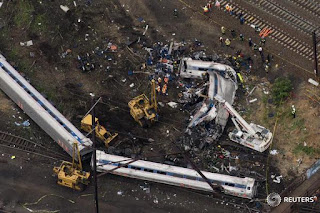June 3, 2015
Washington, DC
Federal investigators looking into the Amtrak derailment that killed eight people and injured scores of others in Philadelphia last month are trying to determine whether the engineer was using his cellphone when his train approached a curve at more than twice the speed limit.
Christopher A. Hart, chairman of the National Transportation Safety Board, told a congressional committee Tuesday that investigators want to know whether train engineer Brandon Bostian, 32, was texting or speaking on the phone as his locomotive accelerated to 106 mph into the bend.
“We know that there is text and voice activity on that day,” Hart said. “We’re trying to narrow down [the time frame]. We were surprised by the complexity ourselves, and we’re experts on this.”
Bostian, through his attorney, said after the May 12 crash that his cellphone was inside his backpack in compliance with federal rules.
Federal
safety regulators and Amtrak officials faced questions at a
congressional hearing June 2, 2015, on why technology to slow trains
that are going too fast was not in place before the deadly derailment in
Philadelphia. (AP)
“And we found [time] discrepancies within the carrier’s own system,” Hart said.
He also said that the clock in the train’s data recorder might show an incrementally different time from that shown on Bostian’s phone.
Although it will be months before the NTSB issues a formal report on the cause of the crash, the focus of the investigation appears to have narrowed to Bostian’s actions. Hart told the committee that there was no indication of problems with the locomotive, track, braking or signal system.
“We need technology that can step in when humans fail,” Hart said.
Sarah Feinberg, acting head of the Federal Railroad Administration, told the committee that within weeks her agency would roll out plans to control for human error.
“Speed, simply put, is what we refer to as a human factor,” said Feinberg, who was nominated by the Obama administration to become permanent head of the FRA.
Entering the turn at 102 mph, the train derailed. Bostian survived with minor injuries, but the passenger car just behind the engine crumpled like a tin can. In addition to those killed, about 200 people were injured.
The question of whether Bostian was using his cellphone at the time of the crash might have been answered if Amtrak trains were equipped with inward-facing video cameras. Amtrak’s president and chief executive, Joseph H. Boardman, said last week that inward-looking cameras would be installed.
Bostian told investigators that he had no memory of what happened immediately before the crash.
“Inward-facing cameras would help fill in those gaps,” Hart told the committee.
“There are privacy concerns about the storage of [camera] data,” he said. “Nobody wants to see their last moment on Earth floating around on YouTube.”
Hart, Feinberg and Boardman spent much of the three-hour hearing answering questions about a safety advance they all agreed would have prevented the accident.
Called positive train control, the system would have automatically slowed the train to a safe speed as it approached the curve. Amtrak has installed the system on all portions of Northeast Corridor track that it owns, but its use has been delayed by problems with bandwidth interference.
Boardman promised that the system would be running by the end of the year, meeting a congressional deadline for its full implementation. Few of the freight rail lines are expected to meet that deadline, and delays will affect Amtrak trains that run on freight lines. Although the passenger rail agency owns portions of track in the Northeast, most of its trains run on freight lines elsewhere.
“Positive train control is the game changer,” said Feinberg, who ordered Amtrak to take four immediate corrective steps after the accident.
“A lot of people around the country have died as a result of the lack of positive train control,” said Rep. Peter A. DeFazio (D-Ore.). “This was probably human error. Positive train control could have prevented that.”
Source: http://www.washingtonpost.com










